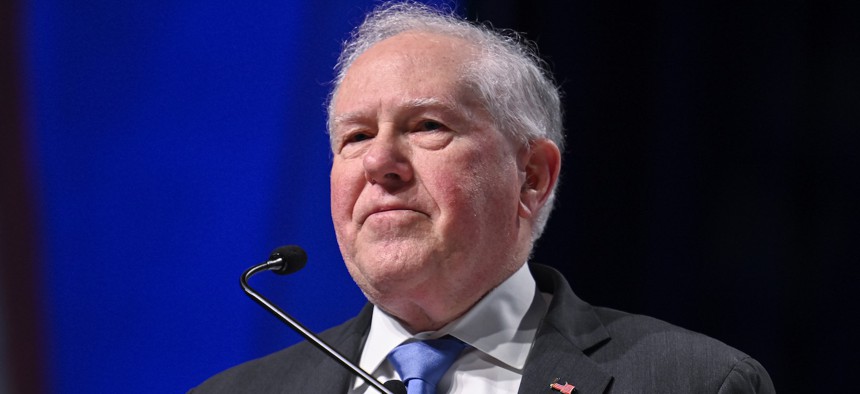
Secretary of the Air Force Frank Kendall speaks at the Air and Space Forces Association 2024 Warfare Symposium in Aurora, Colo., Feb. 12, 2024. U.S. Air Force / Eric Dietrich
Air Force announces major shakeup to prep for war with China
Space Force also lists changes, including a futures command.
AURORA, Colorado—The U.S. Air Force is changing the way it deploys forces as part of a sweeping overhaul to make the service leaner and prepare for a fight against China.
Instead of deploying forces one squadron at a time, and taking people and aircraft from various units throughout the service to meet in theater, the Air Force will now structure wings so they train and deploy together.
Future Air Force wings, or “units of action” as the service calls them in the new plan, will need to get “whole units” ready for conflict.
“We need to ensure that our combat wings are coherent units of action that have everything they need to be able to execute their wartime tasks,” said Air Force Chief of Staff Gen. David Allvin.
The restructuring of air wings is one of a slew of changes announced Monday at the Air & Space Forces Association Warfare Symposium in Colorado. This announcement marks the most significant changes to the Air Force’s current structure in decades, as the service pivots away from the way it deployed forces to the Middle East—a process that won’t work in a bigger fight against China, officials say.
“We are going to turn this enterprise and point it directly at our most challenging threat,” Air Force Secretary Frank Kendall said.
Kendall has been working on this effort, called “Reoptimizing for Great Power Competition” since September, and originally announced his plans to revamp the service in a Sept. 5 letter to airmen.
Service leaders detailed 24 changes for the Air Force and Space Force at the conference, grouped in four categories: “develop people, generate readiness, project power, develop capabilities”
The announcement comes after months of speculation over what exactly this reorganization would entail and if the service would get rid of its major command structure—a move Allvin said is not happening.
But the service is making some changes to its major commands, including standing up a new command. Dubbed “Integrated Capabilities Command” and headed by a three-star general, it will take the major commands out of the requirements process so they can focus on combat readiness, Allvin said. The service hopes the move will remove the burden of modernization planning from the major commands, specifically Air Combat Command.
The service also announced the creation of several new offices to help “integrate” capabilities across the service.
On personnel, Allvin said the service is expanding Air Education and Training Command and renaming it Airman Development Command, to have a more “coherent” force, and to centralize force development under a single commander.
There is also a list of changes for Space Force, including creating a Space Force Futures Command to look at future threats. The new command, which will be made up of three centers, will work to put “together a force that we can offer to combatant commanders that doesn't just have the systems. It has the tactics, the training, the operational concepts, it is leveraging the right technologies to be successful,” said Chief of Space Operations Gen. Chance Saltzman.
Kendall said all of these changes won’t have a “big cost imposition.” The service didn’t ask for any funds in the 2024 or 2025 budget for the effort, but might need some in 2026.
“These changes are going to be done within existing resources, which in some cases, is probably going to mean we'll have to stop doing some of the things we're doing now,” Kendall said, noting that will be identified in the planning process.
However, Allvin said the service will need more money to conduct the large-scale exercises they’re planning to practice their new deployment method.
While some of these changes may not be the right move, service officials said, and a lot of details still need to be worked out, the service can’t risk staying stagnant.
“We do not have them exactly right and I am unapologetic to stand here in front of you and say I do not know the exact final destination and here's why. Because if we wait to move, to have those final answers, we will be too late,” Allvin said.





